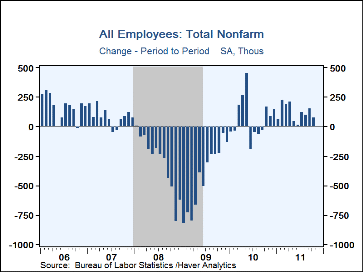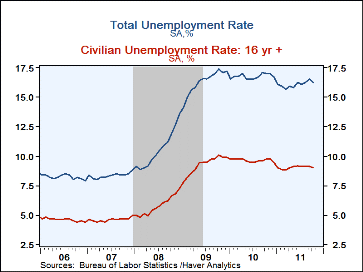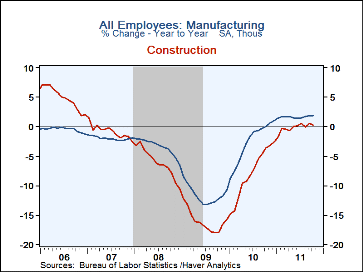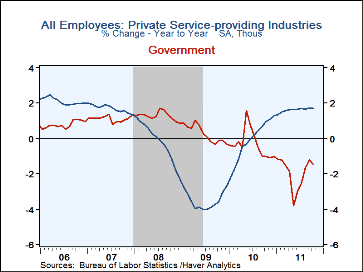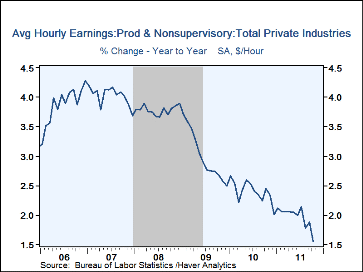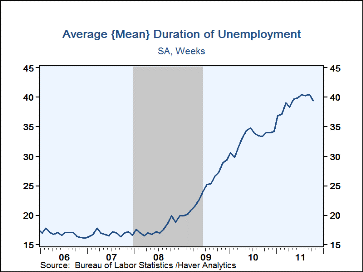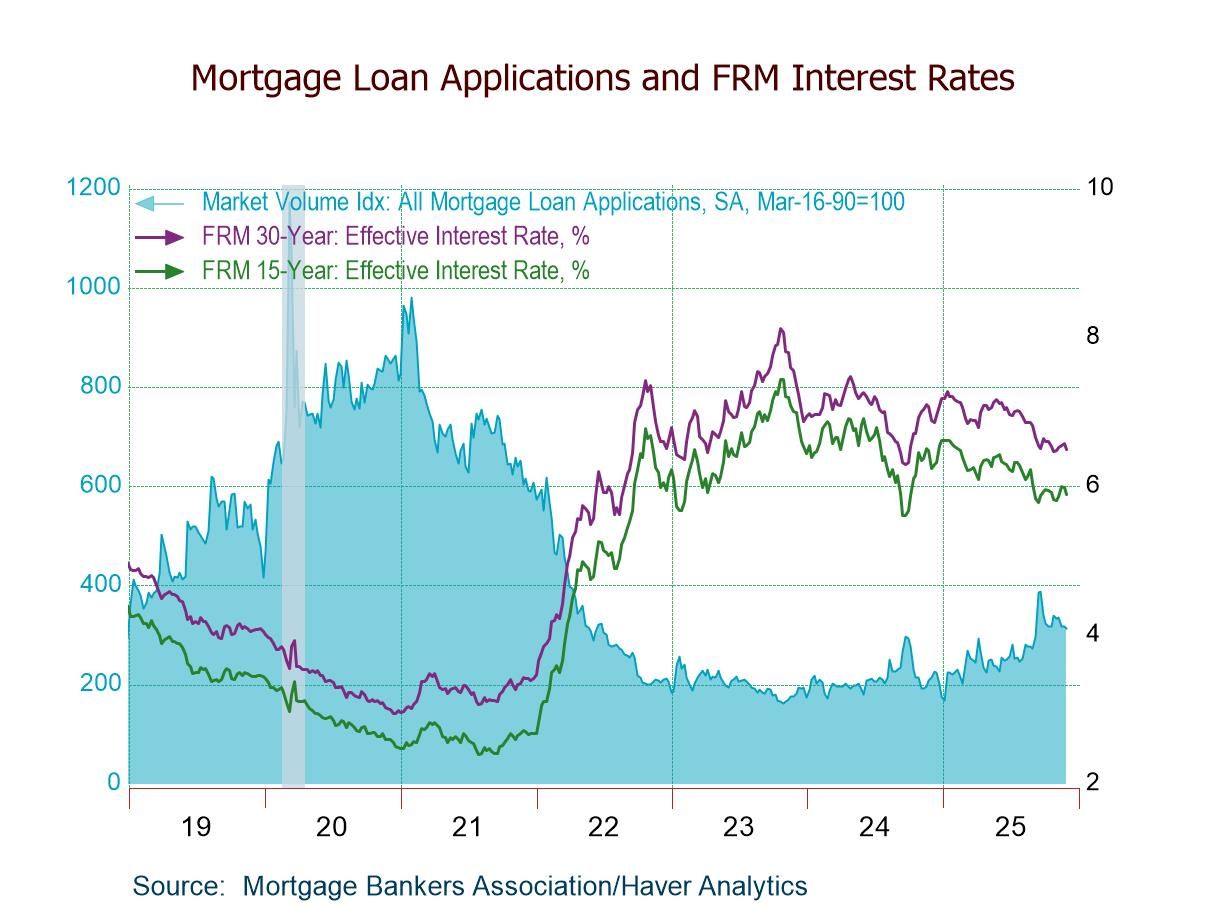 Global| Nov 04 2011
Global| Nov 04 2011U.S. Nonfarm Payrolls Growth Disappoints But Jobless Rate Slips
by:Tom Moeller
|in:Economy in Brief
Summary
Nonfarm payrolls grew just 80,000 during October but the September and August gains were revised up. Consensus expectations had been for a 100,000 increase in jobs last month. Altogether, these latest gains leave growth in employment [...]
Nonfarm payrolls grew just 80,000 during October but the September and August gains were revised up. Consensus expectations had been for a 100,000 increase in jobs last month. Altogether, these latest gains leave growth in employment modest by the standards of past economic recoveries. Moreover, they are weaker than the increases from February-to-April of this year. The same story is true for the unemployment rate. It fell to 9.0% but that remained slightly above the Q1 average. Consensus expectations were for a 9.1% rate last month.
From the establishment survey, nonfarm payrolls increased 80,000 last month following gains of 158,000 and 104,000 in September and August. These gains were revised up. As in prior months, the private service sector led the latest increase with a 114,000 (1.7% y/y) rise versus a 162,000 September addition. Professional & business services led with a strong 32,000 (3.4% y/y) increase. Temporary jobs rose 15,000 (7.9% y/y). Education & health services also rose a firm 28,000 (2.2% y/y) and leisure & hospitality jobs grew 22,000 (1.6% y/y). Retail employment grew 17,8000 (1.1% y/y). A 5,000 (-1.5% y/y) worker decline in information jobs offset these increases somewhat. Construction jobs fell 20,000 with fewer specialty trade contractors. Factory sector employment rose just 5,000 (1.9% y/y), the gain held back by a 6,000 (-0.1% y/y) decline in nondurables. Employment in the government sector has been under pressure from efforts to address budget deficits. The total number of jobs dropped 24,000 (-1.4% y/y) reflecting a 20,000 decline in state (-1.7% y/y), a 2,000 drop in federal (-1.4% y/y) and a 2,000 reduction in local (-1.2% y/y) employment.
Overall, 55.4% of industries added jobs during October while 62.5% increased employment during the last six months.
Average hourly earnings rose 0.2% (1.6% y/y), the same as in September. In goods producing industries earnings rose 1.6% y/y while in service industries they also rose 1.6% y/y. Education & health service industries led the gain with a 2.6% y/y increase and information services also posted a strong 2.0% y/y rise.
From the household survey, the unemployment rate slipped to 9.0% reflecting a 177,000 increase (0.9% y/y) in employment and a 181,000 rise (0.2% y/y) in the labor force. The overall unemployment rate including marginally attached workers and those working part time for economic reasons slipped m/m to 16.2%, down from its high two years ago of 17.4%. In leisure & hospitality the rate was 10.8% and in professional & business services it was 10.1%. The average duration of unemployment slipped to 39.4 weeks and the number of individuals jobless for 52 weeks or longer fell 72,000 (+2.3% y/y). Within the labor force, the number of individuals not included who currently want a job was down 6.3M (-16.2%) from the June peak. The number discouraged over job prospects was down roughly one-quarter from the December peak.
The figures referenced above are available in Haver's USECON database. Additional detail can be found in the LABOR and in the EMPL databases. The expectation figures are from Action Economics and are in the AS1REPNA database.
| Employment: (M/M Chg., 000s) | Oct | Sep | Aug | Y/Y | 2010 | 2009 | 2008 |
|---|---|---|---|---|---|---|---|
| Payroll Employment | 80 | 158 | 104 | 1.2% | -0.7% | -4.4% | -0.6% |
| Previous | -- | 103 | 57 | -- | -- | -- | -- |
| Manufacturing | 5 | -3 | -1 | 1.9 | -2.7 | -11.6 | -3.4 |
| Construction | -20 | 27 | -14 | 0.2 | -8.1 | -16.0 | -6.1 |
| Private Service Producing | 114 | 162 | 85 | 1.7 | -0.1 | -3.5 | -0.2 |
| Government | -24 | -33 | 32 | -1.4 | -0.3 | 0.3 | 1.3 |
| Average Weekly Hours | 34.3 | 34.3 | 34.2 | 34.3 (Oct.'10) |
34.1 | 33.9 | 34.5 |
| Average Hourly Earnings (%) | 0.2 | 0.2 | -0.1 | 1.6 | 2.4 | 3.0 | 3.8 |
| Unemployment Rate(%) | 9.0 | 9.1 | 9.1 | 9.7 (Oct.'10) |
9.6 | 9.3 | 5.8 |
Tom Moeller
AuthorMore in Author Profile »Prior to joining Haver Analytics in 2000, Mr. Moeller worked as the Economist at Chancellor Capital Management from 1985 to 1999. There, he developed comprehensive economic forecasts and interpreted economic data for equity and fixed income portfolio managers. Also at Chancellor, Mr. Moeller worked as an equity analyst and was responsible for researching and rating companies in the economically sensitive automobile and housing industries for investment in Chancellor’s equity portfolio. Prior to joining Chancellor, Mr. Moeller was an Economist at Citibank from 1979 to 1984. He also analyzed pricing behavior in the metals industry for the Council on Wage and Price Stability in Washington, D.C. In 1999, Mr. Moeller received the award for most accurate forecast from the Forecasters' Club of New York. From 1990 to 1992 he was President of the New York Association for Business Economists. Mr. Moeller earned an M.B.A. in Finance from Fordham University, where he graduated in 1987. He holds a Bachelor of Arts in Economics from George Washington University.


